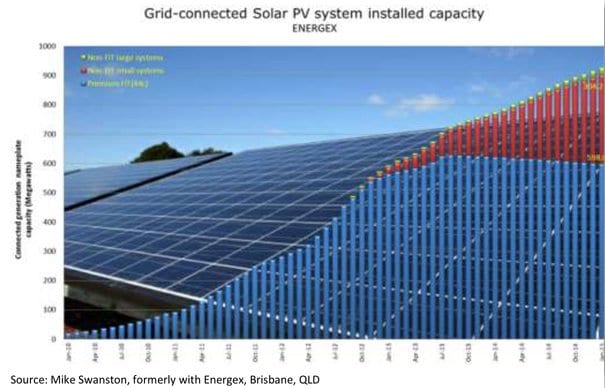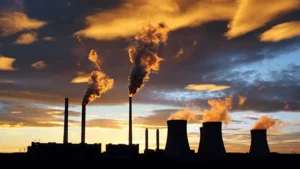Utility business was never glamorous or exciting – but you could normally count on predictable sales and revenue growth. As everything gradually gets more efficient and as mature economies slowly move away from energy-intensive industries, however, electricity demand growth is slowing, or in some cases actually falling, which – assuming all else remains constant – leads to flat or declining revenues. Many believe that US electricity demand has already peaked (graph below).
This would bad enough, but there
are indications that things can get
even worse because a growing
number of customers can
generate a large portion of their
energy service needs through
 distributed self-generation, be
distributed self-generation, be
it solar panels on the roof, a
micro-generator or fuel cell in
the garage or an arrangement
with another customer who has
excess power to spare. There are
examples of semi-independent
networks or micro-grids that
virtually produce as much energy
as they consume. Moreover, as
buildings move towards zero net energy (ZNE), they buy relatively little or none from the grid.
Putting energy efficiency – using less – with distributed self-generation – producing more of what one needs – together one gets distributed energy resources or DERs. For an industry whose basic business model was built on growing volumetric sales and flat or falling retail tariffs, this is an unpleasant double whammy even if the regulatory compact – still prevalent in many parts of the US – allows the incumbent utilities to raise retail tariffs to adjust for the falling volume. As retail tariffs rise, more consumers will find it attractive to invest in DERs, leading to so-called death spiral.
 Trade press – and this newsletter is no exception – have been full of speculation about how the future may unfold and what the longer-term impacts of DERs may be on the industry. Accenture, a consultancy, has released a report that examined 3 future scenarios: status quo, demand disruption and perfect storm. The prognosis gets progressively worse as the names imply (graph on left).
Trade press – and this newsletter is no exception – have been full of speculation about how the future may unfold and what the longer-term impacts of DERs may be on the industry. Accenture, a consultancy, has released a report that examined 3 future scenarios: status quo, demand disruption and perfect storm. The prognosis gets progressively worse as the names imply (graph on left).
The status quo scenario might materialize if one assumes that all existing support and subsidies for distributed generation (DG), most notably net energy metering (NEM) laws that make solar PVs such an attractive option in sunny regions with high retail tariffs, will be phased out by 2018. This scenario also assumes no breakthroughs on technology costs and low customer interest in uptake of DERs.
Very few experts believe that such a combination of factors are likely to prevail making this scenario “wishful thinking” for those who like the status quo.
The other two scenarios, as you might expect, make other assumptions on the key variables and end up with rather different results with significantly lower sales and revenues for the industry. Accenture does not dwell on how they arrived at the
numbers, only claiming that US
residential and commercial sales, excluding prosumer generation, could be anywhere from $18 to $48 billion lower by 2025 compared to the status quo scenario.
A similar exercise for Europe yields results that are even worse: a revenue drop between €39 to €61 billion ($44-69 billion) from the status quo scenario by 2025 (graph on right).
Given the recent pace of growth of
DERs, the status quo will most likely
not prevail. The question is how much
 of an impact may be expected. As the
of an impact may be expected. As the
Accenture analysis suggests, the key
drivers are changes in DER technology,
cost, the level of subsidies, be it NEM
laws – in the US – or feed-in-tariffs
(FiTs) in Europe and customer uptake of
emerging technologies. And in this case, one expert’s guess is probably as good as another.
Those who say reduce or remove the subsidies – say the prevailing NEM laws in the US – and the distributed generation craze will fizzle may be surprised to learn otherwise. In the case of sunny Queensland in Australia, for example, the incredibly generous FITs, at one time 44 cents/kWhr when retail tariffs were roughly half as high, have been substantially reduced and removed and yet customers continue to install solar PVs on rooftops. Not as fast as they used to, but they still do.
 In the case of Energex, the distribution company that serves the greater Metropolitan Brisbane, the initial rush to take advantage of the 44 cents/kWh premium FIT (blue bars in graph on left) is over, yet customers continue to install solar PVs at a rate exceeding 2,000 per month (red bars in graph above).
In the case of Energex, the distribution company that serves the greater Metropolitan Brisbane, the initial rush to take advantage of the 44 cents/kWh premium FIT (blue bars in graph on left) is over, yet customers continue to install solar PVs at a rate exceeding 2,000 per month (red bars in graph above).
 Another worrying trend – that is if you are an incumbent utility keen on selling more kWhrs – is that new buildings are far more energy frugal than the existing ones, which suggests that as time goes on they will consume fewer kWhrs for cooling, heating, lighting, ventilation, appliances, and everything else. In fact, within the next few years, many new
Another worrying trend – that is if you are an incumbent utility keen on selling more kWhrs – is that new buildings are far more energy frugal than the existing ones, which suggests that as time goes on they will consume fewer kWhrs for cooling, heating, lighting, ventilation, appliances, and everything else. In fact, within the next few years, many new
buildings will qualify as zero net energy (ZNE), which means they will produce as much as they consume. In California, for example, all new residential buildings will have to meet such a standard starting in 2020; 2030 for new commercial buildings.
Moreover, rapid advances in micro-grid technology means that entire office buildings, shopping malls, hospitals, university campuses and military facilities can operate energy systems with little net consumption from the outside grid.
It is not hard to see why Accenture arrived at its projections. If anything, Accenture may be off in under- estimating the potential level of revenue erosion that could be experienced by 2025. As described in article on page 13, Europe can prosper economically while using 33% less energy by 2030. More inefficient economies can do even better than that – which is hard to believe.
And it is not just electric power sector that is facing declining sales. Energy consumption in many mature economies appears to be going south, with no end in sight as evident in graph on bottom of page 3 for the UK. The trend started prior to the global financial crisis in 2008, so cannot be attributed to it.
Such trends are among the reasons to question the status quo, wherever you encounter it (see related article on BP, page 7).
Perry Sioshansi is president of Menlo Energy Economics, a consultancy based in San Francisco, CA and editor/publisher of EEnergy Informer, a monthly newsletter with international circulation. He can be reached at [email protected]







